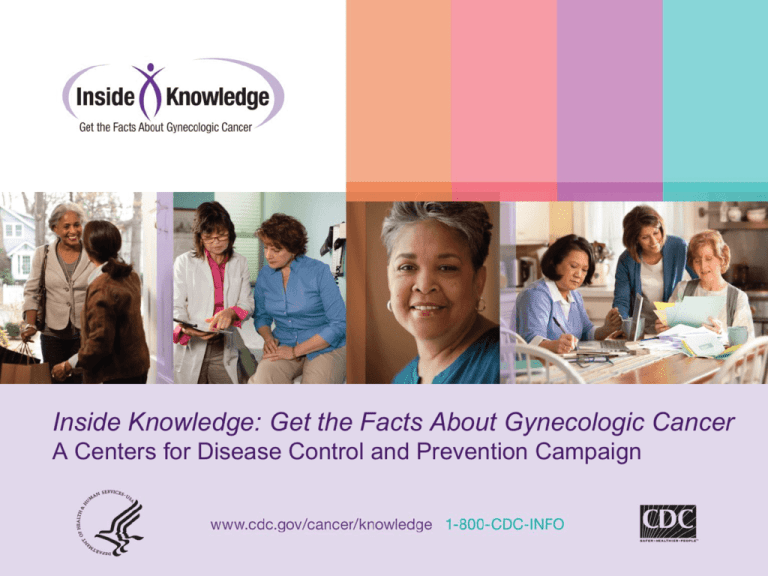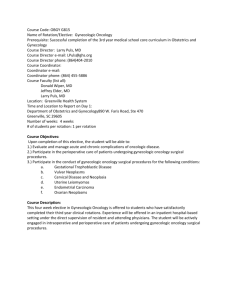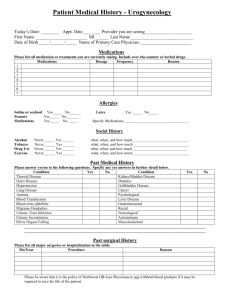CDC*s Gynecologic Cancer Awareness Campaign
advertisement

Inside Knowledge: Get the Facts About Gynecologic Cancer A Centers for Disease Control and Prevention Campaign What We Will Discuss Part I. What You Need to Know About Gynecologic Cancers Part II: Recognizing the Warning Signs Part III: Prevention, Screening, and Treatment Part IV: Inside Knowledge and GFWC What You Need to Know About Gynecologic Cancers Gynecologic Cancer • Gynecologic cancer is any cancer that starts in a woman's reproductive organs. • These cancers begin in different places within a woman's pelvis. • There are five main types of gynecologic cancers: ‒ Ovarian ‒ Uterine ‒ Cervical ‒ Vaginal ‒ Vulvar How Many Women Are Affected? • In the U.S. in 2009 (the last year for which data are available), more than 84,000 women were diagnosed with a gynecologic cancer. • Nearly 28,000 died from a gynecologic cancer in 2009. • Of the five main gynecologic cancers: ‒ Most common – Uterine ‒ Least common – Vaginal ‒ Most preventable – Cervical ‒ Deadliest – Ovarian Who Gets Gynecologic Cancer? • All women are at risk; risk generally increases with age. • Each gynecologic cancer is unique. • Risk factors differ from cancer to cancer. ‒ Cervical: HPV (human papillomavirus) infection ‒ Ovarian: age 50+; having certain genetic risk factors; having several close relatives with ovarian or breast cancer; being of Eastern European Jewish background ‒ Uterine: age 50+, hormone replacement therapy using estrogen alone ‒ Vaginal: age 50+, exposure to HPV ‒ Vulvar: exposure to HPV Recognizing the Warning Signs Recognize Symptoms • Gynecologic cancers have warning signs. • Pay attention to your body so you know what is normal for you. • When gynecologic cancers are found early, treatment can be most effective. The Warning Signs Cervical Cancer Symptoms • Early on, cervical cancer may not cause signs and symptoms. • In later stages, cervical cancer may cause bleeding or discharge from the vagina that is not normal for you. Ovarian Cancer Symptoms Ovarian cancer may cause: • Vaginal bleeding or discharge that is not normal for you. • Pelvic pain or pressure. • Back pain. • Bloating or feeling full quickly while eating. • A change in bathroom habits, such as having to urinate more often than normal and more urgently; and being unusually constipated; or having diarrhea that persists. Uterine Cancer Symptoms Uterine cancer may cause these signs and symptoms: • Vaginal discharge that is not normal for you. • Abnormal vaginal bleeding – because of how heavy it is or when it happens, such as after menopause; between periods; or any other bleeding that is longer or heavier than normal for you. • Pain or pressure in your pelvis. Vaginal Cancer Symptoms Most vaginal cancers don’t cause symptoms at first. But if symptoms are present, they can include: • Vaginal discharge or bleeding that’s not normal for you. • A change in bathroom habits, such as having blood in the stool or urine; urinating more often than usual; feeling constipated. • Pelvic or abdominal pain, especially when urinating or having sex. Vulvar Cancer Symptoms Symptoms of vulvar cancer may include: • Itching, burning, or bleeding on the vulva. • Skin changes, such as the vulva being redder or whiter than is normal for you, or having a rash, warts, lumps, or ulcers that don’t go away. Recognize the Warning Signs Remember – signs and symptoms don’t necessarily mean it’s cancer. But the only way to know what’s causing symptoms is to see a health care provider. Gynecologic cancers are more treatable and beatable when they are caught early. Prevention, Screening, and Treatment Cervical Cancer Screening Two tests help prevent cervical cancer or find it early: 1. The Pap test (or Pap smear) looks for precancers, cell changes, on the cervix that can be treated, so that cervical cancer is prevented. • Can detect cervical cancer at an early stage, when treatment works best • Recommended for all women starting at age 21. ‒ If results are normal, you may be able to wait 3 years for the next one. ‒ After several normal Pap tests and upon reaching age 65, your doctor may say you can stop getting the Pap test. • Women who don’t need a Pap are: ‒ Older than 65, with a history of normal Pap test results. ‒ Have had their cervix removed as part of a hysterectomy for a non-cancerous condition, like fibroids. Cervical Cancer Screening Two tests help prevent cervical cancer or find it early: 2. The HPV test looks for the Human Papillomavirus — the virus that can cause precancerous cell changes and cervical cancer. • Can be used to screen for cervical cancer along with the Pap test in women 30 years and older. • Also used to provide more information when women aged 21 years and older have unclear Pap test results. Cervical Cancer Prevention The HPV Vaccine • Given in a series of three shots, it protects against the types of HPV that most often cause cervical, vaginal, and vulvar cancers. • Recommended for 11- and 12-year-old girls and for girls and women aged 13-26 who did not get any or all of the shots when they were younger. • The vaccine can be given to girls beginning at age 9. Gynecologic Cancer Diagnosis • Tests used to diagnose gynecologic cancers include: - Transvaginal ultrasound - CA-125 blood test - Biopsies of the appropriate gynecologic organs • Genetic tests Treatment for Gynecologic Cancer • Treatment for gynecologic cancer typically may include ‒ Surgery ‒ Chemotherapy ‒ Radiation therapy • Following diagnosis ‒ Ask to be referred to a gynecologic oncologist—a doctor specifically trained to treat these women’s cancers ‒ Find out about cancer staging Ask Your Health Care Provider 1. 2. 3. 4. 5. 6. What is my risk for getting a gynecologic cancer? When should I have my next Pap test? What do my Pap test results mean? Is the HPV test right for me? When can I stop getting a Pap test? Are there other gynecologic cancer tests that I need, based on my personal health and family cancer history? 7. I have noticed [insert any symptom you are experiencing], which is not normal for me. Could this be caused by a gynecologic cancer? If so, what should I do next? The Inside Knowledge Campaign and GFWC The Campaign’s Origins • In 2007, Congress enacted Johanna’s Law (the Gynecologic Cancer Awareness Act). ─ The law is named for Johanna Silver Gordon, who died from ovarian cancer in 2000. • The law aims to increase awareness of gynecologic cancers, and their signs, symptoms and risk factors, to more effectively prevent, detect and treat these cancers. Campaign Goals • The Centers for Disease Control and Prevention (CDC) launched Inside Knowledge: Get the Facts About Gynecologic Cancer in collaboration with the Dept. of Health and Human Services’ Office on Women’s Health. • The campaign has three primary goals: 1. Raise awareness of the signs, symptoms, risk factors, and prevention strategies related to the five main types of gynecologic cancer: cervical, ovarian, uterine, vaginal, and vulvar. 2. Encourage women to pay attention to their bodies and know what is normal for them, to increase recognition of warning signs and symptoms. 3. Encourage women to seek medical attention and ask about gynecologic cancers when faced with warning signs that persist. From Woman to Woman Inside Knowledge uses a womanto-woman approach, to: • • • Offer audiences the opportunity to connect with “real” women, especially survivors, who can speak about gynecologic cancer. Reflect women’s tendency to seek counsel from friends and loved ones. Provide important information in a straightforward but compelling manner. “Be brave. Ask questions.” “Warning signs are not the same for everyone” Free Campaign Materials Free Campaign Materials Inside Knowledge and GFWC The CDC works with GFWC to: • Disseminate Inside Knowledge resources to GFWC clubs nationwide. • Share survivors’ stories at events, meetings, conventions, and in Clubwoman magazine. • Provide members with tools to educate women in their communities. Inside Knowledge and GFWC As a GWFC member, you can help educate women about gynecologic cancer: • Provide Inside Knowledge materials to other GFWC members, colleagues, friends, and family. • Host a workshop for friends about gynecologic cancer, using Inside Knowledge resources. • Share campaign resources with local media and encourage them to use the materials. Inside Knowledge and GFWC You can also use Inside Knowledge resources during key holidays and women’s health observances: • National Cervical Cancer Awareness Month (January) • Mother’s Day (May) • National Gynecologic Cancer Awareness Month (September) • National Ovarian Cancer Awareness Month (September) Let’s encourage women to get the facts and the Inside Knowledge about gynecologic cancer. Contact Us To see or hear PSAs, order materials, and learn more, please visit www.cdc.gov/cancer/knowledge For additional information about Inside Knowledge, please contact alexandra.vaughn@ogilvy.com (202) 729-4263







